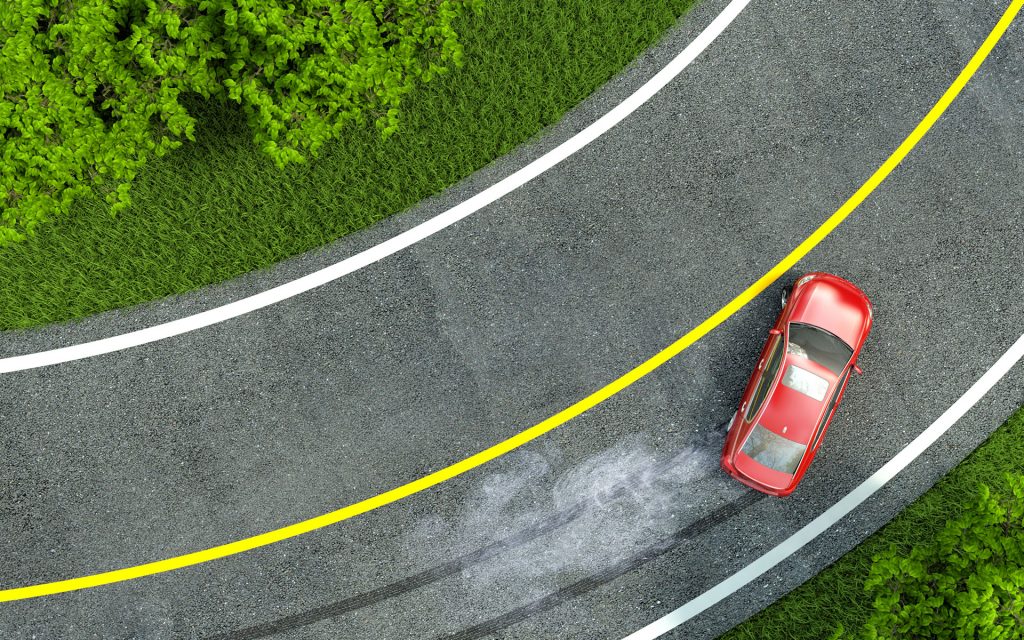How to Recover from Front Wheel Skids and Slides
Icy or slippery conditions on the road can be difficult and potentially dangerous because of the possibility of skidding. Getting into a skid might cause drivers to lose control of their vehicles and potentially cause a major accident. Skids happen for many reasons, but drivers can learn techniques for recovering and regaining control of their vehicles quickly and easily. Knowing how to recover from a front wheel skid or slide is an important skill that all drivers should know.
According to Jason Tchir in his January 2020 article in the Globe and Mail, vehicles can skid for one of several reasons. Driving too quickly for the conditions, especially on slippery roads, is a common cause of skidding. Others include turning the steering wheel too sharply, braking or accelerating too quickly or being blown by a strong gust of wind.
The road surface is an important component in skidding. Rainwater, ice, snow, wet leaves or oils and other fluids that have dripped from passing vehicles can form a barrier between the road and the tires, reducing traction and making it harder for the tire’s treads to grip the surface. When that happens, the vehicle might begin to slide in the wrong direction, and the driver must take action to prevent an accident.
Severity of Skids
Some skids are minor and require only a slight readjustment of the steering wheel to correct the vehicle’s direction. With anything more serious, however, drivers might tend to panic and react in a way that increases the danger of a skid rather than helping to return the vehicle to a more stable course. On an empty road, the consequences of this type of reaction might not be very serious. However, in heavy traffic, panic can cause multiple crashes and possibly serious injuries or deaths.

Avoiding panic is difficult in many situations, but with the right techniques and a knowledge of how to deal with various situations, drivers can more easily deal with skids if and when they occur. The best tactic is to try to avoid skids altogether if possible. No one can predict exactly what situations may cause vehicles to skid, but certain precautions can help. Some of these precautions take place before drivers ever get behind the wheel, but others happen on the road.
Precautions for Avoiding Skids
The first precaution is to ensure that the treads on all of the vehicle’s wheels are adequate for the conditions, whether the tires are specifically for summer or winter, or are all-season tires. Part of the issue is the quality of the tires. Although the average vehicle owner is unlikely to be an expert on tires, it can be useful to do a bit of research on the best brands and on recommendations for different types of vehicles.
How and where people drive will also affect how quickly tire treads wear down. Frequent use of a vehicle, especially on rough surfaces like gravel, can wear the treads on the tires down to a point where they no longer grip the road effectively. Tires that are either underinflated or overinflated can also cause problems. They are designed to work with a certain amount of air, and a substantial change in the amount of inflation can make them less effective.
The second precaution may seem obvious, but drivers often fail to follow this basic safeguard: driving according to the conditions on the road. Whenever the weather conditions are wet, icy or snowy, vehicles can easily slip and slide along the road. Driving slowly can help reduce the chances of skidding, as hard braking is less likely to be necessary, and vehicle operators can more easily respond to any slight changes in traction before the tires entirely lose their grip on the road.

The third precaution for avoiding skids is to keep an appropriate distance from the vehicle in front. That way, the driver will have time to stop if the first vehicle brakes unexpectedly. Skidding to a stop just centimetres behind another vehicle can be frightening, besides potentially scaring other drivers. On city streets, about the length of two or three cars is usually enough, but drivers should leave more space at higher speeds or in hazardous conditions.
A fourth technique for avoiding skids is to slow down for curves and to avoid braking while in the process. Going around a curve too quickly exacerbates any errors in steering that the driver may make, while braking can cause the wheels to lock and the vehicle to slide out of control. This action can even potentially send the vehicle off the road.
Travelling at reduced speeds can help. On curves in cities and towns, drivers should look for the suggested speeds listed on orange signs at the beginning of the curve. On highways, engineering techniques usually angle the roads so that drivers can continue travelling at high speeds, but it is still important to watch for anything that might make curves dangerous.
Possible Dangers
Some of the issues that might cause problems for drivers could be an unexpectedly sharp curve or anything on the road’s surface, such as ice or snow, which could increase the dangers of travelling at the speed limit. Being forced to slow down quickly on a curve may cause a vehicle to skid, especially if the driver is trying to concentrate on too many things at once, such as the vehicle’s speed or any other traffic on the road.
Even if drivers use the best techniques for avoiding a skid, they can still lose control over their vehicles. At that point, they should know how to recover from a skid and to return safely to their route. Recovering from minor skids can be easy for drivers who know a few basic techniques, but serious skids can be more difficult and require the driver to take drastic action. Preventing these major skids can take some skill, but learning the right techniques and putting them into practice can help.
The Wrong Techniques
Being able to recover from a skid is an essential part of learning how to drive, but sometimes students learn the wrong techniques. For example, as Jason Tchir notes, driving instructors have traditionally told students to turn the steering wheel in the direction of the skid in order to get their vehicles back on track. However, this can be confusing, and drivers may not be able to tell which way the vehicle is skidding.
If the front and back of the vehicle are skidding in different directions, for example, drivers may have a difficult time deciding which way to go. In these types of situations, drivers may panic, as well, making it even more difficult for them to make a rational decision. They need a more intuitive and simpler method of recovering from a skid.
The Right Way to Stop a Skid
A better alternative exists, according to Tchir. Instead of trying to determine the direction of the skid, drivers should look towards the direction they want to follow. With their focus on that spot, they will tend to steer in that course, helping to stop the skid before it becomes any worse.
Steering is an essential part of recovering from a skid. When the skid first begins, drivers may react by oversteering and possibly driving into another lane or going off the road. In most cases, small adjustments in steering are the best option for correcting a skid and ensuring that the vehicle returns to the right path. Drivers may need to make several adjustments as they go along, but this can work well as long as they are travelling at a reasonable pace.
Speed is another important aspect of recovering from a skid. If a vehicle is travelling too quickly for the conditions, the driver is less likely to be able to react in time to prevent a serious accident than someone travelling at a slower speed. Similarly, braking or accelerating too quickly is likely to cause the vehicle to spin out of control if it begins to skid.
The exact techniques for recovering from a skid depend on the situation. For front wheel skids, the Practical Motoring website recommends easing off the accelerator or the throttle to allow the vehicle to slow down. This allows the wheels to grip the ground again before the driver presses the accelerator. Drivers should look in the direction they want to go, as far ahead as they can.
It is a good idea to wait two or three seconds after releasing the accelerator to see if that will help bring the vehicle under control. If that does not work, gentle pressure on the brakes will help transfer power to the front of the vehicle and normally help bring it under control. For vehicles without anti-lock brakes, pumping the brakes lightly can help.
Troubles with Braking
During a skid, a common reaction is sudden, firm braking to attempt to stop the vehicle or at least slow it down. However, as the Ontario Ministry of Transportation’s website explains, braking should be gentle in conditions where skids are likely to occur, such as on icy roads. Otherwise, the forces working on the tires may push them closer to a skid.
If these tactics are ineffective, shifting into neutral can help keep the vehicle from sliding further, or at least slow it down somewhat. That can give the driver time to counteract the skid and bring the vehicle under control again.
Recovering from a skid is not an easy process, especially with the quick reaction time and control that are necessary. The circumstances of each skid are different, but if drivers know the theory, they can more easily train themselves to react in ways that help them recover from a skid rather than getting into an accident. Quickly recovering from a skid can help drivers and other road users stay safe.
